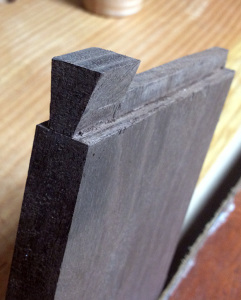Joinery Problem Solving
 I think the problem solving aspect of woodworking is one of my favorite elements. You take all of your knowledge of wood movement, joint strength, and technique and bring them to bear on a single issue to devise a solution. Then you get to figure out a way to execute that solution. Usually that method is best done as a repeatable process since often multiple parts are needed over the course of you project. The great part is that once you figure out the steps, the solution, no matter how complex seems like a piece of cake.
I think the problem solving aspect of woodworking is one of my favorite elements. You take all of your knowledge of wood movement, joint strength, and technique and bring them to bear on a single issue to devise a solution. Then you get to figure out a way to execute that solution. Usually that method is best done as a repeatable process since often multiple parts are needed over the course of you project. The great part is that once you figure out the steps, the solution, no matter how complex seems like a piece of cake.
Recently I backed myself into a corner by losing track of grain direction in a SketchUp model. My joinery solution looked perfect for strength and execution wasn’t a problem. Then I got to real wood and suddenly realized my joinery would be very weak and I would violate all the space/time laws of wood movement causing uncontrollable tachyon bursts that completely disrupt all sub-space traffic. Funny how the problem and the solution is always those pesky tachyons…
sorry, I turned off the Start Trek episode playing in the background…
So I sat back and began to problem solve. The bottom of the tool box I’m building needs to resist pulling out of the bottom of the carcass as the weight of a drawer will rest on it. But I cannot use dovetails as this would put them cross grain to my sides which are also dovetailed with the grain running parallel to the bottom. A through sliding dovetail would potentially weaken the sides since it would have to be position right by the edge of the board. A simple groove would work fine just like a drawer bottom but without something resisting the outward pull, the bottom panel would be relying entirely on glue strength. A big problem because gluing the entire tongue and groove would then violate wood movement rules bringing back those tachyons again. So why not compromise?
 My end solution is a hybrid between a sliding dovetail and a tongue and groove and now the bottom panel is 3 pieces instead of 1. The 3 pieces are dry fit with tongue and groove joinery and the outer parts are glued in to the case with sliding dovetails. Did I mention the whole case is canted in at a compound angle? So all my joinery surfaces need to be at a 10 degree bias.
My end solution is a hybrid between a sliding dovetail and a tongue and groove and now the bottom panel is 3 pieces instead of 1. The 3 pieces are dry fit with tongue and groove joinery and the outer parts are glued in to the case with sliding dovetails. Did I mention the whole case is canted in at a compound angle? So all my joinery surfaces need to be at a 10 degree bias.
Remember what I said about solutions seeming complex?
Enter the process. With detailed layout and thinking about the finished joint, I can visualize what parts need to come away and the best order to do that. How I remove the wood plays a big part in this too. With angles everywhere in this joint most of my planes are useless so it comes down to saw and chisel. In the end 6 saw cuts and 2 chisel passes shaped my joint.
Your Turn
Can you figure out where these cuts happened and in what order? How would you create this joint?
Please leave your thoughts in the comments below.
![]() **Problem solving like this happens every day in The Hand Tool School. This project is one of 4 covered in Semester alone and it presents many interesting problems to solve. Join today, all the cool kids are already there!
**Problem solving like this happens every day in The Hand Tool School. This project is one of 4 covered in Semester alone and it presents many interesting problems to solve. Join today, all the cool kids are already there!



